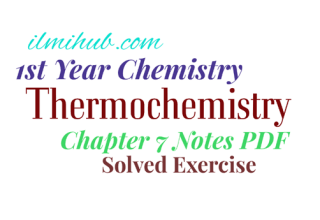In this post, I am sharing FSC 1st Year Chemistry Chapter 11 Solved Exercise PDF Notes for the students of FSC Part 1. The name of 11th Chemistry Chapter 11 is Reaction Kinetics. So the students can download Reaction Kinetics Chapter Solved Exercise in PDF format from here. This file contains 14 pages. These Chemistry Notes are for all the boards working under Punjab Board like Gujranwala Board, Lahore Board, Faisalabad Board, Multan Board, Rawalpindi Board, Sargodha Board, DG Kahn Board, and Sahiwal Board. Here are the complete 1st Year Chemistry Notes.
11th Class Chemistry Chapter 11 “Reaction Kinetics” Solved Exercise PDF Download
In zero order reaction, the rate is independent of:
a) temperature of reaction
b) concentration of reaction
c) concentration of product
d) none of these
The rate of reaction :
a) increase as the reaction proceeds
b) decreases as the reaction preceeds
c) remain the same as the reaction proceeds
d) may decrease or increase as the reaction proceeds
The unit of rate constant is the same as that of the rate of reaction in:
a) first order reaction
b) second order reaction
c) zero order reaction
d) third order reaction
Fill in the blanks:
i) The rate of endothermic reaction increases with the increase in temperature.
ii) All radioactive disintegration nuclear reactions are of greater and half life is shorter
iii) Arrhenius equation can be used to find out activation energy of a reaction
what is chemical kinetics? How do you compare chemical kinetics with chemical kinetics with chemical equilibrium and thermodynamic?
The study of rate of chemical reactions and factors affecting the rate of chemical reactions is called as “Chemical kinetics”.
Difference between chemical kinetics and chemical equilibrium:
| Chemical kinetics | Chemical equilibrium |
| The study of rate and mechanism of reaction is called chemical kinetics. | A state of reversible reaction at which forward and backward rates become equal is called chemical equilibrium. |
| Rate study is possible for both reversible reaction | Chemical equilibrium is the characteristics of reversible reactions only |
| It is related to rate of reactions and factors affecting it | It is related to state of equilibrium and factors affecting it |
what is instantaneous and average rate.
Instantaneous rate:
“The rate of reaction at any one instant furing the interval is called instantaneous rate”.
Instantaneous rate of reaction= DC/Dt
Average rate:
” The rate of reaction between two specific time intervals is called the average rate of reaction”
Average rate of reaction = dx/dt
Relevent Notes
1st Year Chemistry Chapter 1 solved Exercise PDF
11th Chemistry Chapter 2 solved Exercise PDF
1st Year Chemistry Chapter 3 solved Exercise PDF
11th Class Chemisrty Chapter 4 Solved exercise PDF
1st Year Chemistry Chapter 6 solved Exercise PDF
FSC Part 1 Chemistry Chapter 8 solved Exercise PDF
FSC 1st Year Chemistry Chapter 9 solved Exercise PDF
11th Class Chemistry Chapter 10 Solved Exercise PDF





